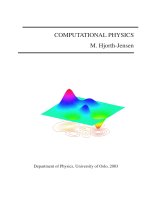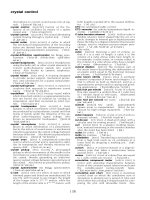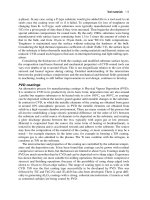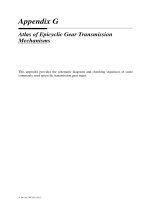Computational Physics - M. Jensen Episode 1 Part 7 docx
Bạn đang xem bản rút gọn của tài liệu. Xem và tải ngay bản đầy đủ của tài liệu tại đây (259.32 KB, 20 trang )
8.3. GAUSSIAN QUADRATURE 109
and we note that in both cases the error goes like . With the latter two expressions we can
now approximate the function
as
(8.10)
Inserting this formula in the integral of Eq. (8.3) we obtain
(8.11)
which is Simpson’s rule. Note that the improved accuracy in the evaluation of the derivatives
gives a better error approximation,
vs. . But this is just the local error approxima-
tion. Using Simpson’s rule we can easily compute the integral of Eq. (8.1) to be
(8.12)
with a global error which goes like
. It can easily be implemented numerically through the
following simple algorithm
Choose the number of mesh points and fix the step.
calculate and
Perform a loop over to ( and are known) and sum up
the terms
. Each
step in the loop corresponds to a given value . Odd values of give
as factor while even values yield as factor.
Multiply the final result by .
A critical evaluation of these methods will be given after the discussion on Guassian quadra-
ture.
8.3 Gaussian quadrature
The methods we have presented hitherto are taylored to problems where the mesh points are
equidistantly spaced,
differing from by the step . These methods are well suited to cases
where the integrand may vary strongly over a certain region or if we integrate over the solution
of a differential equation.
110 CHAPTER 8. NUMERICAL INTEGRATION
If however our integrand varies only slowly over a large interval, then the methods we have
discussed may only slowly converge towards a chosen precision
1
. As an example,
(8.13)
may converge very slowly to a given precision if
is large and/or varies slowly as function
of
at large values. One can obviously rewrite such an integral by changing variables to
resulting in
(8.14)
which has a small integration range and hopefully the number of mesh points needed is not that
large.
However there are cases where no trick may help, and where the time expenditure in evaluat-
ing an integral is of importance. For such cases, we would like to recommend methods based on
Gaussian quadrature. Here one can catch at least two birds with a stone, namely, increased preci-
sion and fewer (less time) mesh points. But it is important that the integrand varies smoothly over
the interval, else we have to revert to splitting the interval into many small subintervals and the
gain achieved may be lost. The mathematical details behind the theory for Gaussian quadrature
formulae is quite terse. If you however are interested in the derivation, we advice you to consult
the text of Stoer and Bulirsch [3], see especially section 3.6. Here we limit ourselves to merely
delineate the philosophy and show examples of practical applications.
The basic idea behind all integration methods is to approximate the integral
(8.15)
where
and are the weights and the chosen mesh points, respectively. In our previous discus-
sion, these mesh points were fixed at the beginning, by choosing a given number of points .
The weigths
resulted then from the integration method we applied. Simpson’s rule, see Eq.
(8.12) would give
(8.16)
for the weights, while the trapezoidal rule resulted in
(8.17)
In general, an integration formula which is based on a Taylor series using
points, will integrate
exactly a polynomial
of degree . That is, the weights can be chosen to satisfy
linear equations, see chapter 3 of Ref. [3]. A greater precision for a given amount of numerical
work can be achieved if we are willing to give up the requirement of equally spaced integration
points. In Gaussian quadrature (hereafter GQ), both the mesh points and the weights are to
1
You could e.g., impose that the integral should not change as function of increasing mesh points beyond the
sixth digit.
8.3. GAUSSIAN QUADRATURE 111
be determined. The points will not be equally spaced
2
. The theory behind GQ is to obtain an
arbitrary weight
through the use of so-called orthogonal polynomials. These polynomials are
orthogonal in some interval say e.g., [-1,1]. Our points are chosen in some optimal sense
subject only to the constraint that they should lie in this interval. Together with the weights we
have then
( the number of points) parameters at our disposal.
Even though the integrand is not smooth, we could render it smooth by extracting from it the
weight function of an orthogonal polynomial, i.e., we are rewriting
(8.18)
where
is smooth and is the weight function, which is to be associated with a given orthogonal
polynomial.
The weight function
is non-negative in the integration interval such that for
any
is integrable. The naming weight function arises from the fact that it
may be used to give more emphasis to one part of the interval than another. In physics there are
several important orthogonal polynomials which arise from the solution of differential equations.
These are Legendre, Hermite, Laguerre and Chebyshev polynomials. They have the following
weight functions
Weight function Interval Polynomial
Legendre
Hermite
Laguerre
Chebyshev
The importance of the use of orthogonal polynomials in the evaluation of integrals can be
summarized as follows.
As stated above, methods based on Taylor series using points will integrate exactly a
polynomial of degree . If a function can be approximated with a polynomial
of degree
with mesh points we should be able to integrate exactly the polynomial .
Gaussian quadrature methods promise more than this. We can get a better polynomial
approximation with order greater than to and still get away with only mesh
points. More precisely, we approximate
2
Typically, most points will be located near the origin, while few points are needed for large values since the
integrand is supposed to vary smoothly there. See below for an example.
112 CHAPTER 8. NUMERICAL INTEGRATION
and with only mesh points these methods promise that
(8.19)
The reason why we can represent a function
with a polynomial of degree is
due to the fact that we have equations, for the mesh points and for the weights.
The mesh points are the zeros of the chosen orthogonal polynomial of order
, and the weights
are determined from the inverse of a matrix. An orthogonal polynomials of degree defined in
an interval
has precisely distinct zeros on the open interval .
Before we detail how to obtain mesh points and weights with orthogonal polynomials, let
us revisit some features of orthogonal polynomials by specializing to Legendre polynomials. In
the text below, we reserve hereafter the labelling
for a Legendre polynomial of order ,
while is an arbitrary polynomial of order . These polynomials form then the basis for the
Gauss-Legendre method.
8.3.1 Orthogonal polynomials, Legendre
The Legendre polynomials are the solutions of an important differential equation in physics,
namely
(8.20)
is a constant. For we obtain the Legendre polynomials as solutions, whereas
yields the so-called associated Legendre polynomials. This differential equation arises in e.g.,
the solution of the angular dependence of Schrödinger’s equation with spherically symmetric
potentials such as the Coulomb potential.
The corresponding polynomials
are
(8.21)
which, up to a factor, are the Legendre polynomials . The latter fulfil the orthorgonality
relation
(8.22)
and the recursion relation
(8.23)
It is common to choose the normalization condition
(8.24)
8.3. GAUSSIAN QUADRATURE 113
With these equations we can determine a Legendre polynomial of arbitrary order with input
polynomials of order
and .
As an example, consider the determination of
, and . We have that
(8.25)
with
a constant. Using the normalization equation we get that
(8.26)
For
we have the general expression
(8.27)
and using the orthorgonality relation
(8.28)
we obtain
and with the condition , we obtain , yielding
(8.29)
We can proceed in a similar fashion in order to determine the coefficients of
(8.30)
using the orthorgonality relations
(8.31)
and
(8.32)
and the condition we would get
(8.33)
We note that we have three equations to determine the three coefficients
, and .
Alternatively, we could have employed the recursion relation of Eq. (8.23), resulting in
(8.34)
which leads to Eq. (8.33).
114 CHAPTER 8. NUMERICAL INTEGRATION
The orthogonality relation above is important in our discussion of how to obtain the weights
and mesh points. Suppose we have an arbitrary polynomial
of order and a Legendre
polynomial of order . We could represent by the Legendre polynomials through
(8.35)
where
’s are constants.
Using the orthogonality relation of Eq. (8.22) we see that
(8.36)
We will use this result in our construction of mesh points and weights in the next subsection In
summary, the first few Legendre polynomials are
(8.37)
(8.38)
(8.39)
(8.40)
and
(8.41)
The following simple function implements the above recursion relation of Eq. (8.23). for com-
puting Legendre polynomials of order
.
/ / This f unc tio n computes the Legendre polynomial of degree N
double l ege n dre ( in t n , double x)
{
double r , s , t ;
in t m;
r = 0 ; s = 1 . ;
/ / Use r ecu rsi on r e l a t io n to generate p1 and p2
for (m= 0; m < n ; m++ )
{
t = r ; r = s ;
s = (2 m+1) x r m t ;
} / / end of do loop
return s ;
} / / end of fu nc ti on legendre
The variable represents , while holds and the value .
8.3. GAUSSIAN QUADRATURE 115
8.3.2 Mesh points and weights with orthogonal polynomials
To understand how the weights and the mesh points are generated, we define first a polynomial of
degree
(since we have variables at hand, the mesh points and weights for points).
This polynomial can be represented through polynomial division by
(8.42)
where
and are some polynomials of degree or less. The function
is a Legendre polynomial of order .
Recall that we wanted to approximate an arbitrary function with a polynomial in
order to evaluate
we can use Eq. (8.36) to rewrite the above integral as
(8.43)
due to the orthogonality properties of the Legendre polynomials. We see that it suffices to eval-
uate the integral over
in order to evaluate . In addition, at the
points where is zero, we have
(8.44)
and we see that through these
points we can fully define and thereby the integral.
We develope then in terms of Legendre polynomials, as done in Eq. (8.35),
(8.45)
Using the orthogonality property of the Legendre polynomials we have
(8.46)
where we have just inserted ! Instead of an integration problem we need now to define
the coefficient . Since we know the values of at the zeros of , we may rewrite Eq.
(8.45) as
(8.47)
Since the Legendre polynomials are linearly independent of each other, none of the columns in
the matrix
are linear combinations of the others. We can then invert the latter equation and
have
(8.48)
116 CHAPTER 8. NUMERICAL INTEGRATION
and since
(8.49)
we see that if we identify the weights with
, where the points are the zeros of , we
have an integration formula of the type
(8.50)
and if our function
can be approximated by a polynomial of degree , we have
finally that
(8.51)
In summary, the mesh points
are defined by the zeros of while the weights are given by
.
8.3.3 Application to the case
Let us visualize the above formal results for the case . This means that we can approximate
a function with a polynomial of order .
The mesh points are the zeros of
. These points are
and
.
Specializing Eq. (8.47)
to yields
(8.52)
and
(8.53)
since
and .
The matrix
defined in Eq. (8.47) is then
(8.54)
8.3. GAUSSIAN QUADRATURE 117
with an inverse given by
(8.55)
The weights are given by the matrix elements
. We have thence and .
Summarizing, for Legendre polynomials with we have weights
(8.56)
and mesh points
(8.57)
If we wish to integrate
with , we approximate
(8.58)
The exact answer is
. Using with the above two weights and mesh points we get
(8.59)
the exact answer!
If we were to emply the trapezoidal rule we would get
(8.60)
With just two points we can calculate exactly the integral for a second-order polynomial since
our methods approximates the exact function with higher order polynomial. How many points
do you need with the trapezoidal rule in order to achieve a similar accuracy?
8.3.4 General integration intervals for Gauss-Legendre
Note that the Gauss-Legendre method is not limited to an interval [-1,1], since we can always
through a change of variable
(8.61)
rewrite the integral for an interval [a,b]
(8.62)
118 CHAPTER 8. NUMERICAL INTEGRATION
If we have an integral on the form
(8.63)
we can choose new mesh points and weights by using the mapping
(8.64)
and
(8.65)
where
and are the original mesh points and weights in the interval , while and
are the new mesh points and weights for the interval .
To see that this is correct by inserting the the value of
(the lower end of the interval
) into the expression for . That gives , the lower end of the interval . For
, we obtain . To check that the new weights are correct, recall that the weights
should correspond to the derivative of the mesh points. Try to convince yourself that the above
expression fulfils this condition.
8.3.5 Other orthogonal polynomials
Laguerre polynomials
If we are able to rewrite our integral of Eq. (8.18) with a weight function
with
integration limits , we could then use the Laguerre polynomials. The polynomials form
then the basis for the Gauss-Laguerre method which can be applied to integrals of the form
(8.66)
These polynomials arise from the solution of the differential equation
(8.67)
where is an integer and a constant. This equation arises e.g., from the solution of the
radial Schrödinger equation with a centrally symmetric potential such as the Coulomb potential.
The first few polynomials are
(8.68)
(8.69)
(8.70)
(8.71)
8.3. GAUSSIAN QUADRATURE 119
and
(8.72)
They fulfil the orthorgonality relation
(8.73)
and the recursion relation
(8.74)
Hermite polynomials
In a similar way, for an integral which goes like
(8.75)
we could use the Hermite polynomials in order to extract weights and mesh points. The Hermite
polynomials are the solutions of the following differential equation
(8.76)
A typical example is again the solution of Schrödinger’s equation, but this time with a harmonic
oscillator potential. The first few polynomials are
(8.77)
(8.78)
(8.79)
(8.80)
and
(8.81)
They fulfil the orthorgonality relation
(8.82)
and the recursion relation
(8.83)
120 CHAPTER 8. NUMERICAL INTEGRATION
Table 8.1: Mesh points and weights for the integration interval [0,100] with using the
Gauss-Legendre method.
1 1.305 3.334
2 6.747 7.473
3 16.030 10.954
4 28.330 13.463
5 42.556 14.776
6 57.444 14.776
7 71.670 13.463
8 83.970 10.954
9 93.253 7.473
10 98.695 3.334
8.3.6 Applications to selected integrals
Before we proceed with some selected applications, it is important to keep in mind that since
the mesh points are not evenly distributed, a careful analysis of the behavior of the integrand as
function of
and the location of mesh points is mandatory. To give you an example, in the Table
below we show the mesh points and weights for the integration interval [0,100] for
points obtained by the Gauss-Legendre method. Clearly, if your function oscillates strongly in
any subinterval, this approach needs to be refined, either by choosing more points or by choosing
other integration methods. Note also that for integration intervals like e.g.,
, the
Gauss-Legendre method places more points at the beginning of the integration interval. If your
integrand varies slowly for large values of , then this method may be appropriate.
Let us here compare three methods for integrating, namely the trapezoidal rule, Simpson’s
method and the Gauss-Legendre approach. We choose two functions to integrate, namely
and
A program example which uses the trapezoidal rule, Simpson’s rule and the Gauss-Legendre
method is included here.
# include < iostream >
# include
using namespace st d ;
/ / Here we d ef in e va rio u s f u n c t i o ns c al le d by the main program
/ / t hi s fu nc ti on d e fi ne s the f u n ct i on to in t eg r a te
double i n t_ f u nc t io n ( double x) ;
8.3. GAUSSIAN QUADRATURE 121
/ / Main fu nc t i on begins here
in t main ( )
{
in t n ;
double a , b ;
cout < < < < endl ;
cin > > n ;
cout < < < < endl ;
cin > > a > > b ;
/ / res erv e space in memory fo r ve ct or s cont ain ing the mesh po i nt s
/ / weights and f un c ti o n va lue s fo r the use of the gauss legendre
/ / method
double x = new double [ n ] ;
double w = new double [ n ] ;
/ / s e t up the mesh poi nt s and wei ghts
gauleg ( a , b , x ,w, n ) ;
/ / eva lua t e the i n te g r al with the Gauss Legendre method
double i nt _g au s s = 0 . ;
for ( in t i = 0 ; i < n ; i ++){
i n t_ ga us s +=w[ i ] i nt _ f un c ti o n ( x [ i ] ) ;
}
/ / fi n a l out put
cout < < < < t r a p ez o i d al _ r u l e ( a , b , n ,
i n t_ f u n c t i o n )
<< endl ;
cout < < < < simpson (a , b , n , i n t_ f un c t io n )
<< endl ;
cout < < < < in t_ ga us s < < endl ;
de let e [ ] x ;
de let e [ ] w;
return 0 ;
} / / end of main program
/ / t h i s f un ct i on d e f i ne s the fu n ct io n to i nt e gr a t e
double i n t_ f u nc t io n ( double x )
{
double val ue = 4 . / ( 1 . + x x) ;
return value ;
} / / end of f u nc t io n t o eva l uat e
In Table 8.2 we show the results for the first integral using various mesh points, while Table
8.3 displays the corresponding results obtained with the second integral. We note here that, since
the area over where we integrate is rather large and the integrand goes slowly to zero for large
values of
, both the trapezoidal rule and Simpson’s method need quite many points in order to
approach the Gauss-Legendre method. This integrand demonstrates clearly the strength of the
Gauss-Legendre method (and other GQ methods as well), viz., few points are needed in order to
122 CHAPTER 8. NUMERICAL INTEGRATION
Table 8.2: Results for using three different methods as functions of the num-
ber of mesh points
.
Trapez Simpson Gauss-Legendre
10 1.821020 1.214025 0.1460448
20 0.912678 0.609897 0.2178091
40 0.478456 0.333714 0.2193834
100 0.273724 0.231290 0.2193839
1000 0.219984 0.219387 0.2193839
achieve a very high precision.
The second Table however shows that for smaller integration intervals, both the trapezoidal
rule and Simpson’s method compare well with the results obtained with the Gauss-Legendre
approach.
Table 8.3: Results for
using three different methods as functions of the number
of mesh points
.
Trapez Simpson Gauss-Legendre
10 0.798861 0.799231 0.799233
20 0.799140 0.799233 0.799233
40 0.799209 0.799233 0.799233
100 0.799229 0.799233 0.799233
1000 0.799233 0.799233 0.799233
8.4 Treatment of singular Integrals
So-called principal value (PV) integrals are often employed in physics, from Green’s functions
for scattering to dispersion relations. Dispersion relations are often related to measurable quan-
tities and provide important consistency checks in atomic, nuclear and particle physics. A PV
integral is defined as
(8.84)
and arises in applications of Cauchy’s residue theorem when the pole
lies on the real axis
within the interval of integration .
An important assumption is that the function
is continuous on the interval of integration.
In case is an analytic expression or it has an analytic continuation in the complex plane,
it may be possible to obtain an expression on closed form for the above integral.
8.4. TREATMENT OF SINGULAR INTEGRALS 123
However, the situation which we are often confronted with is that is only known at some
points
with corresponding values . In order to obtain we need to resort to a numerical
evaluation.
To evaluate such an integral, let us first rewrite it as
(8.85)
where we have isolated the principal value part in the last integral.
Defining a new variable
, we can rewrite the principal value integral as
(8.86)
One possibility is to Taylor expand around , and compute derivatives to a certain
order as we did for the Trapezoidal rule or Simpson’s rule. Since all terms with even powers of
in the Taylor expansion dissapear, we have that
(8.87)
To evaluate higher-order derivatives may be both time consuming and delicate from a numer-
ical point of view, since there is always the risk of loosing precision when calculating derivatives
numerically. Unless we have an analytic expression for
and can evaluate the derivatives
in a closed form, the above approach is not the preferred one.
Rather, we show here how to use the Gauss-Legendre method to compute Eq. (8.86). Let us
first introduce a new variable
and rewrite Eq. (8.86) as
(8.88)
The integration limits are now from
to , as for the Legendre polynomials. The principal
value in Eq. (8.88) is however rather tricky to evaluate numerically, mainly since computers have
limited precision. We will here use a subtraction trick often used when dealing with singular
integrals in numerical calculations. We introduce first the calculus relation
(8.89)
It means that the curve has equal and opposite areas on both sides of the singular point
.
If we then note that is just a constant, we have also
(8.90)
124 CHAPTER 8. NUMERICAL INTEGRATION
Subtracting this equation from Eq. (8.88) yields
(8.91)
and the integrand is now longer singular since we have that
and
for the particular case the integrand is now finite.
Eq. (8.91) is now rewritten using the Gauss-Legendre method resulting in
(8.92)
where are the mesh points ( in total) and are the weights.
In the selection of mesh points for a PV integral, it is important to use an even number of
points, since an odd number of mesh points always picks
as one of the mesh points. The
sum in Eq. (8.92) will then diverge.
Let us apply this method to the integral
(8.93)
The integrand diverges at
. We rewrite it using Eq. (8.91) as
(8.94)
since
. With Eq. (8.92) we have then
(8.95)
The exact results is
. With just two mesh points we recall from the previous
subsection that and that the mesh points are the zeros of , namely
and . Setting and inserting these values in the last equation gives
With six mesh points we get even the exact result to the tenth digit
We can repeat the above subtraction trick for more complicated integrands. First we modify
the integration limits to and use the fact that
(8.96)
8.4. TREATMENT OF SINGULAR INTEGRALS 125
It means that the curve has equal and opposite areas on both sides of the singular
point
. If we break the integral into one over positive and one over negative , a change of
variable allows us to rewrite the last equation as
(8.97)
We can use this to express a principal values integral as
(8.98)
where the right-hand side is no longer singular at , it is proportional to the derivative
, and can be evaluated numerically as any other integral.
Such a trick is often used when evaluating scattering equations in momentum space, which
are nothing but mere rewriting, for the non-relativistic case, of the Schrödinger equation from
coordinate space to momentum space. We are going to solve numerically the scattering equation
in momentum space in the chapter on eigenvalue equations, see Chapter 13.
Chapter 9
Outline of the Monte-Carlo strategy
9.1 Introduction
Monte Carlo methods are widely used, from the integration of multi-dimensional integrals to
problems in chemistry, physics, medicine, biology, or Dow-Jones forecasting!
Numerical methods that are known as Monte Carlo methods can be loosely described as
statistical simulation methods, where statistical simulation is defined in quite general terms to be
any method that utilizes sequences of random numbers to perform the simulation.
Statistical simulation methods may be contrasted to conventional numerical discretization
methods, which typically are applied to ordinary or partial differential equations that describe
some underlying physical or mathematical system. In many applications of Monte Carlo, the
physical process is simulated directly, and there is no need to even write down the differential
equations that describe the behavior of the system. The only requirement is that the physical
(or mathematical) system be described by probability distribution functions (PDF’s). Once the
PDF’s are known, the Monte Carlo simulation can proceed by random sampling from the PDF’s.
Many simulations are then performed (multiple “trials” or “histories”) and the desired result is
taken as an average over the number of observations (which may be a single observation or
perhaps millions of observations). In many practical applications, one can predict the statistical
error (the “variance”) in this average result, and hence an estimate of the number of Monte Carlo
trials that are needed to achieve a given error. If we assume that the physical system can be
described by a given probability density function, then the Monte Carlo simulation can proceed
by sampling from these PDF’s, which necessitates a fast and effective way to generate random
numbers uniformly distributed on the interval [0,1]. The outcomes of these random samplings,
or trials, must be accumulated or tallied in an appropriate manner to produce the desired result,
but the essential characteristic of Monte Carlo is the use of random sampling techniques (and
perhaps other algebra to manipulate the outcomes) to arrive at a solution of the physical problem.
In contrast, a conventional numerical solution approach would start with the mathematical model
of the physical system, discretizing the differential equations and then solving a set of algebraic
equations for the unknown state of the system. It should be kept in mind though that this general
description of Monte Carlo methods may not directly apply to some applications. It is natural
127
128 CHAPTER 9. OUTLINE OF THE MONTE-CARLO STRATEGY
to think that Monte Carlo methods are used to simulate random, or stochastic, processes, since
these can be described by PDF’s. However, this coupling is actually too restrictive because
many Monte Carlo applications have no apparent stochastic content, such as the evaluation of
a definite integral or the inversion of a system of linear equations. However, in these cases and
others, one can pose the desired solution in terms of PDF’s, and while this transformation may
seem artificial, this step allows the system to be treated as a stochastic process for the purpose of
simulation and hence Monte Carlo methods can be applied to simulate the system.
There are, at least four ingredients which are crucial in order to understand the basic Monte-
Carlo strategy. These are
1. Random variables,
2. probability distribution functions (PDF),
3. moments of a PDF
4. and its pertinent variance
.
All these topics will be discussed at length below. We feel however that a brief explanation may
be appropriate in order to convey the strategy behind a Monte-Carlo calculation. Let us first
demistify the somewhat obscure concept of a random variable. The example we choose is the
classic one, the tossing of two dice, its outcome and the corresponding probability. In principle,
we could imagine being able to exactly determining the motion of the two dice, and with given
initial conditions determine the outcome of the tossing. Alas, we are not capable of pursuing
this ideal scheme. However, it does not mean that we do not have a certain knowledge of the
outcome. This partial knowledge is given by the probablity of obtaining a certain number when
tossing the dice. To be more precise, the tossing of the dice yields the following possible values
(9.1)
These values are called the domain. To this domain we have the corresponding probabilities
(9.2)
The numbers in the domain are the outcomes of the physical process tossing the dice. We cannot
tell beforehand whether the outcome is 3 or 5 or any other number in this domain. This defines
the randomness of the outcome, or unexpectedness or any other synonimous word which encom-
passes the uncertitude of the final outcome. The only thing we can tell beforehand is that say
the outcome 2 has a certain probability. If our favorite hobby is to spend an hour every evening
throwing dice and registering the sequence of outcomes, we will note that the numbers in the
above domain
(9.3)
appear in a random order. After 11 throws the results may look like
(9.4)









